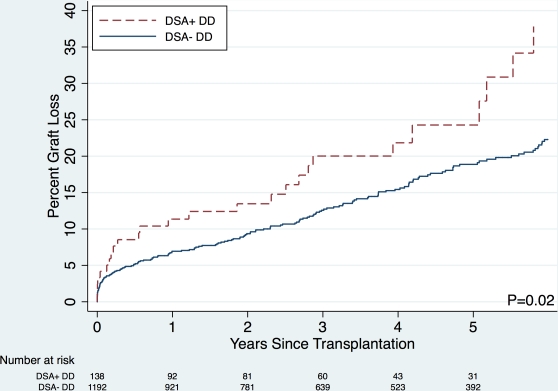Deceased Donor Kidney Transplantation in the Setting of Positive Donor-Specific Antibodies.
1Johns Hopkins University, Baltimore
2University of Michigan, Ann Arbor.
Meeting: 2016 American Transplant Congress
Abstract number: C20
Keywords: Alloantibodies, Graft survival, Kidney transplantation, Rejection
Session Information
Session Name: Poster Session C: Antibody Mediated Rejection: Session #1
Session Type: Poster Session
Date: Monday, June 13, 2016
Session Time: 6:00pm-7:00pm
 Presentation Time: 6:00pm-7:00pm
Presentation Time: 6:00pm-7:00pm
Location: Halls C&D
Recent changes to the kidney allocation system favor highly sensitized transplant candidates, resulting in these patients receiving more offers for deceased donor (DD) kidneys. Despite the increase in offers, many of these patients will have low-level donor-specific antibody (DSA). We reviewed the outcomes of DD kidney transplants in patients with negative cytotoxic crossmatches but with detectable DSA at the time of transplant.
From 2000-2014, 1193 DSA- and 137 DSA+ (10.3%) DD kidney transplants were performed
| DSA+ | DSA- | P-Value | |
| Mean Age (SD) | 49.6 (12.6) | 54.9 (13.3) | <0.001 |
| Female | 60.1% | 37.3% | <0.001 |
| Prior Transplant | 47.1% | 12.3% | <0.001 |
| Black Race | 57.2% | 48.3% | 0.047 |
|
Diabetes as ESRD Etiology |
14.5% | 22.6% | 0.028 |
| Median Peak PRA (IQR) | 90 (52-100) | 2 (0-22) | <0.001 |
. Amongst DSA+ patients, 47.8% had DSA strength sufficient to produce a positive flow cytometric crossmatch and 52.2% were detectable by Luminex only. Antibody-mediated rejection (AMR) occurred in 1.3% of DSA- DD recipients, and 39.1% of DSA+ DD recipients (52.2% with DSA detectable on Luminex, and 47.8% flow positive). There was no difference in overall survival between DSA+ and DSA- patients (P=0.11); however, death-censored graft loss was significantly worse for DSA+ patients (P=0.02) . In a multivariate regression model of graft loss adjusting for DSA status and strength, ECD status, DCD status, year of transplant, prior transplant, donor age, and etiology of recipient's ESRD, neither the presence (P=0.82) nor the strength (P=0.67) of the DSA was associated with graft loss. Development of AMR appears to mediate the association between DSA+ status and graft loss (aHR 2.31; 95%CI:1.17-4.59;P=0.016). ECD (aHR 1.53; 95%CI:1.03-2.29;P=0.037) and DCD (aHR 1.60;95%CI:1.08-2.35) status were also independently associated with graft loss.
. In a multivariate regression model of graft loss adjusting for DSA status and strength, ECD status, DCD status, year of transplant, prior transplant, donor age, and etiology of recipient's ESRD, neither the presence (P=0.82) nor the strength (P=0.67) of the DSA was associated with graft loss. Development of AMR appears to mediate the association between DSA+ status and graft loss (aHR 2.31; 95%CI:1.17-4.59;P=0.016). ECD (aHR 1.53; 95%CI:1.03-2.29;P=0.037) and DCD (aHR 1.60;95%CI:1.08-2.35) status were also independently associated with graft loss.
As more DD offers are made to highly sensitized recipients, the incidence of crossmatch-negative but low-level DSA+ transplants can be expected to increase. This argues for the need for further strategies to prevent and treat AMR.
CITATION INFORMATION: Orandi B, Montgomery J, Kraus E, Segev D, Montgomery R, Alachkar N. Deceased Donor Kidney Transplantation in the Setting of Positive Donor-Specific Antibodies. Am J Transplant. 2016;16 (suppl 3).
To cite this abstract in AMA style:
Orandi B, Montgomery J, Kraus E, Segev D, Montgomery R, Alachkar N. Deceased Donor Kidney Transplantation in the Setting of Positive Donor-Specific Antibodies. [abstract]. Am J Transplant. 2016; 16 (suppl 3). https://atcmeetingabstracts.com/abstract/deceased-donor-kidney-transplantation-in-the-setting-of-positive-donor-specific-antibodies/. Accessed January 2, 2026.« Back to 2016 American Transplant Congress
